Worming Goats: A Comprehensive Guide to Parasitic Control

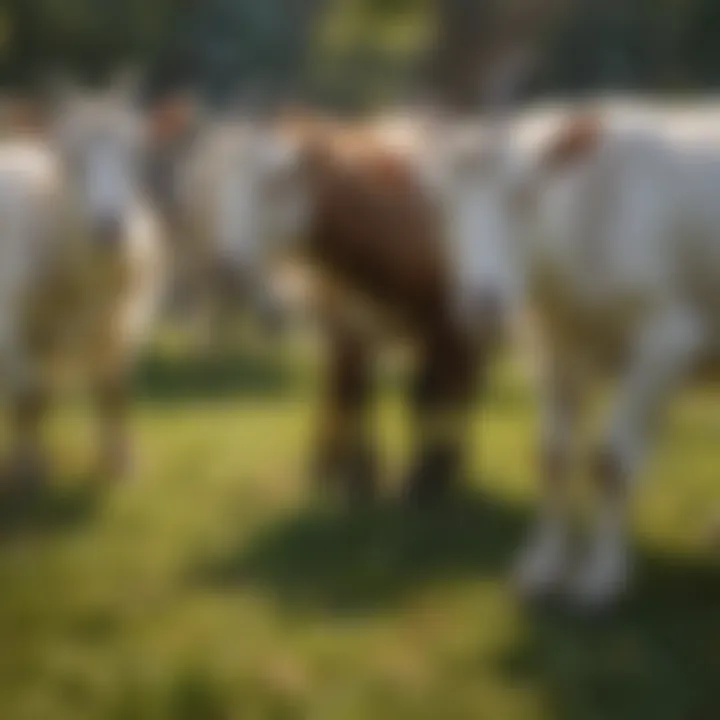
Overview of the Topic
Definition and Importance
Worming goats is an essential practice in livestock management. It focuses on controlling parasitic infections, which can significantly impact the health and productivity of goats. When parasites infest a herd, they can cause weight loss, decreased milk production, and even animal death. Understanding the types of parasites that affect goats and the best way to manage them is crucial for any goat farmer or enthusiast. The implications of neglecting worming practices extend beyond individual livestock, affecting whole herds and ultimately, the sustainability of farming operations.
Current Trends
In recent years, there has been increasing awareness about antibiotic resistance among parasites. This has led to the development of new worming strategies tailored to combat resistance while ensuring the health of goats. Integrated pest management, which combines chemical controls with other strategies, is gaining popularity. Farmers are becoming more knowledgeable about testing for worm levels before treatment, allowing for more targeted and effective control measures.
Key Techniques and Practices
Step-by-Step Guide
- Identify the Parasites: The first step in worming is identifying the type of parasites in the herd. Common parasites include gastrointestinal nematodes, coccidia, and liver flukes. Each type requires specific treatments.
- Monitor for Signs of Infestation: First, observe goats for key symptoms of parasite infection. Signs may include weight loss, lethargy, diarrhea, or a rough coat. Regular fecal exams can help determine the parasite load in goats.
- Choose the Right Dewormer: Select a suitable anthelmintic agent based on the identified parasite. Ivermectin and Albendazole are common choices, but they may not be effective against all types of parasites.
- Administer Treatment: Follow the manufacturer’s guidelines for dosage and administration. Dewormers can be given orally or by injection, depending on the product used.
- Repeat as Necessary: Monitor the goats after treatment and conduct follow-up fecal exams. This ensures the treatment was effective and helps determine if additional doses are needed.
Tools and Equipment Needed
- Fecal Exam Kit: Essential for diagnosing the level of infection in the herd.
- Dewormers: Such as Ivermectin or Fenbendazole, depending on the type of parasite.
- Syringes or Drench Guns: Used for administering liquid dewormers effectively.
- Scale: For accurately weighing goats to determine the correct dosage of medication.
Challenges and Solutions
Common Obstacles
Goat farmers face several challenges in effective worming. Resistance to anthelmintics is one major concern. Overuse of certain dewormers can lead to parasites adapting and surviving treatments. Additionally, differences in the goats' health status can affect treatment efficacy.
Innovative Solutions
One way to address resistance is to implement a rotation of different types of dewormers. This helps prevent the build-up of resistant parasites. Another solution involves incorporating good management practices, such as:
- Avoiding overgrazing to reduce parasite exposure.
- Implementing a pasture rotation system to help break the life cycle of parasites.
- Regularly testing fecal matter to monitor parasite levels, allowing for targeted treatments.
"Effective parasite management is critical for the sustainability of goat farming. Adopting integrated approaches can enhance herd health and reduce dependency on chemical treatments."
By understanding these aspects of worming goats, one can better manage herd health and productivity. Knowledge of techniques, challenges, and innovative solutions will empower goat farmers to adopt more sustainable practices.
Understanding Goat Parasites
Understanding goat parasites is pivotal for anyone involved in goat husbandry. Parasites can significantly affect the health and productivity of goats, leading to costly consequences. Knowledge of these parasites helps farmers make informed decisions about prevention and management. By gaining insight into the various types of parasites and their impacts, goat owners can implement effective control measures.
Common Types of Internal Parasites
Roundworms
Roundworms are among the most common internal parasites found in goats. They are nematodes, which can inhabit the gastrointestinal tract and cause various health issues. A key characteristic of roundworms is their ability to reproduce rapidly, leading to large infestations if not managed appropriately.
The presence of roundworms can result in blood loss and malnutrition, severely affecting the overall health of the goat. Recognizing their potential for rapid reproduction and associated health risks is essential for the management strategies in this article. However, they can also develop resistance to commonly used dewormers, which is a challenging aspect for goat farmers.
Tape Worms
Tape worms are another type of internal parasite that impacts goats. These flatworms attach to the intestinal wall and absorb nutrients from their host. One unique feature of tape worms is their segmented structure, which makes it easy to identify during fecal examinations.
Their presence usually signals an underlying issue, such as poor management conditions or inadequate grazing practices. Tape worms can lead to malnutrition and digestive issues, affecting the productivity of the herd. While they may not reproduce as quickly as roundworms, their ability to foster long-term infestations poses a threat that cannot be ignored.
Flukes
Flukes are flat, leaf-shaped parasites that typically inhabit the liver and other organs of goats. They can enter the goat's system through contaminated water or by consuming infected intermediate hosts, such as snails. Flukes can cause significant liver damage and, in severe cases, can be fatal. Their life cycle is quite complex, involving multiple hosts, which can complicate control efforts.
Understanding the environmental conditions that favor fluke infestation, such as wet pastures, is crucial. Farmers must be proactive in managing their goats' grazing environments to control these parasites effectively.
External Parasites Affecting Goats
Ticks
Ticks are external parasites that latch onto goats to feed on their blood. They can transmit various diseases, like anaplasmosis and Lyme disease, leading to severe health implications. Ticks thrive in warm, humid environments and are most active in spring and summer.
They require careful monitoring since they can cause anemia and weaken the goat. Implementing proper pasture management and regular checks on goats can help reduce tick infestations. Ticks can develop resistance to certain pesticides, so rotation of control methods is necessary.
Lice
Lice are another common external parasite in goats. These small insects live on the skin and feed on blood and skin debris. A key feature of lice is that they can reproduce rapidly, leading to heavy infestations if left unchecked. They typically thrive in poor hygiene conditions.
Infested goats often show signs of itching and discomfort, which can lead to decreased productivity. Regular grooming and maintaining clean living environments are effective strategies for controlling lice.
Mites
Mites are microscopic parasites that can cause significant irritation and skin conditions in goats. They burrow into the skin, causing inflammation and discomfort. One common mite affecting goats is the sarcoptic mite, which can lead to scabies.
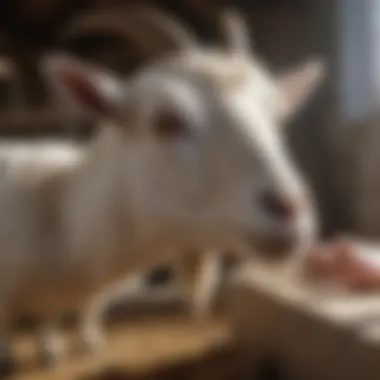
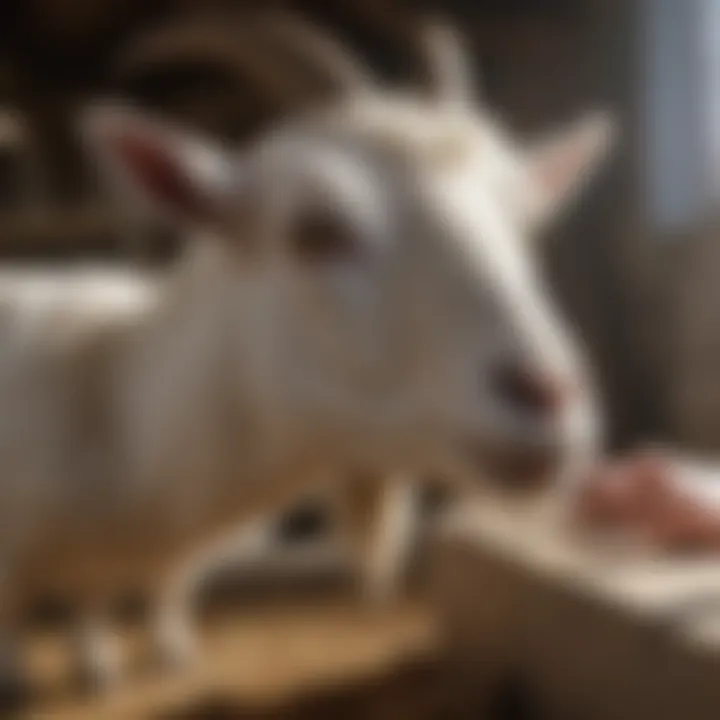
Their presence can severely affect the goat's coat condition and overall health. Managing mites involves a combination of good hygiene practices and appropriate antiparasitic treatments. Failure to address mite infestations can lead to secondary infections and further health problems.
Signs of Parasitic Infestation
Understanding the signs of parasitic infestation in goats is crucial for effective herd management. Early detection allows for timely intervention, which can mitigate the negative impacts of parasites on goat health. Failure to recognize these signs can lead to serious health issues, reduced productivity, and economic losses. Thus, recognizing the signs can serve as a proactive approach in maintaining the overall well-being of goats and the sustainability of goat farming practices.
Physical Symptoms to Observe
Weight Loss
Weight loss in goats is a significant marker of parasitic activity. Parasites consume nutrients that goats need for growth and maintenance. A goat losing weight may display a gaunt appearance and reduced body condition score. This symptom is particularly noticeable in adult goats and can signal a serious health concern. Observing weight loss early enables farmers to consider management changes or initiate deworming protocols quickly. This proactive measure could help mitigate further detrimental impacts, ensuring that goats maintain their nutritional intake and overall health.
Poor Coat Condition
The condition of a goat's coat can also indicate parasitic issues. A poor coat may appear dull and rough instead of glossy and healthy. External parasites, like lice and mites, can contribute to such conditions. Additionally, internal parasites can affect the overall health, leading to fur that fails to thrive. By paying attention to changes in coat condition, farmers can take action to address potential infestations. Identifying poor coat conditions aids in guiding timely and effective treatments, ultimately improving the goat's quality of life.
Diarrhea
Diarrhea is a common symptom associated with parasites. It can lead to dehydration, weakness, and increased susceptibility to further health challenges. If diarrhea persists, it may indicate severe infestations and warrants immediate attention. Observing fecal consistency can provide insights into the overall health of goats and the effectiveness of deworming strategies. Thus, recognizing diarrhea as a warning signal is essential in maintaining herd health and addressing underlying parasitic issues adequately.
Behavioral Indicators
Lethargy
Lethargy reflects a lack of energy and an unwillingness to engage in normal activities. It is often a result of parasitic infections depleting the goat’s energy levels. When goats seem tired and unresponsive, this may signal potential parasitic challenges. Observing behavioral changes can help adjust management strategies to ensure the animals receive appropriate care and attention, thus enabling a healthier environment.
Reduced Grazing
Reduced Grazing is another indicator that goats may be experiencing some health issues. If a goat is eating significantly less than its peers, it may signal discomfort caused by internal or external parasites. This behavior suggests that an investigation into the potential underlying cause is necessary. Monitoring grazing patterns can prompt early intervention, helping to restore health more effectively.
Isolation from Herd
Isolation from the herd can indicate illness or distress in goats. If a goat consistently separates itself, it can suggest that it is feeling unwell, possibly due to parasitic infestation. Observing such behavior provides important information about the animal's health. Addressing isolation promptly can prevent spreading potential parasitic infections and encourage the recovery of the affected goat.
Recognizing the signs of parasitic infestation is essential. Early intervention not only protects individual goats but also strengthens the overall health of the herd.
The Importance of Regular Worming
Worming goats is essential for ensuring their overall health and productivity. Goats are particularly susceptible to various parasites, which can cause significant health issues if left untreated. Regular worming helps control these parasites and ultimately benefits the goat's well-being, productivity, and the farmer's bottom line. In this section, we will explore the multiple facets of why regular worming is critical, focusing on health impacts as well as economic implications.
Impact on Goat Health
Nutritional Deficiencies
Nutritional deficiencies are a direct result of parasitic infestations. When goats are infected with parasites, their ability to absorb nutrients is severely compromised. This leads to weight loss and overall poor condition. Due to their parasitic load, goats often cannot utilize the feed they consume effectively. Regular worming minimizes this risk, ensuring that goats maintain healthy body weights and metabolic functions. By addressing these deficiencies early through effective worming practices, the farmer can encourage optimal growth and production in their flock.
Reproductive Issues
Reproductive issues can arise from the stress that parasites place on the health of the goat. Healthy goats are more likely to have successful breeding seasons, deliver healthy kids, and support them properly afterward. Infected goats may experience problems such as low fertility rates, higher abortion rates, or complications during birthing. Regularly worming goats helps reduce these risks and supports reproductive health. This not only contributes to the animal's quality but also boosts productivity as it increases the number of viable offspring.
Overall Immunity
Overall immunity is another critical aspect affected by parasites. Goats with high parasite loads often display weakened immune responses. This makes them more prone to diseases that can spread rapidly in a herd setting. Worming not only helps in reducing the existing parasite population but also enhances the goats' ability to resist other infections. Stronger immune systems mean healthier goats, which translates to fewer veterinary expenses and improved herd stability.
Economic Implications
Cost of Treatment vs. Losses
The costs associated with treating goats for parasitic infections can add up quickly. However, when considering the costs of treatment against potential losses, regular worming emerges as a cost-effective solution. If a parasite infestation goes unchecked, it may lead to severe health impacts, ultimately resulting in higher veterinary bills, poor growth rates, and in extreme cases, death. Preventive worming can save farmers significant sums in the long run by reducing the chances of extensive treatment and associated losses.
Market Value of Healthy Goats
The market value of healthy goats is significantly influenced by their health status. Buyers are more inclined to invest in goats that show signs of good health and vitality. Regular worming practices not only improve the overall health of goats but also enhance their market appeal. Goats that consistently display good health will fetch a higher price, benefiting the farmer's financial situation. The increased market value of goats can often justify the ongoing costs associated with preventive worming measures, creating a positive feedback loop that aids in herd management.
"Regular worming is not just a health measure; it is a critical investment in the productivity and economic viability of goat farming."
In summary, regular worming is vital not only for the health of goats but also for economic sustainability. Farmers must prioritize worming as part of their herd management practices to ensure a healthy, productive flock.
Methods of Deworming Goats
Deworming goats is a critical aspect of managing their health and productivity. Many factors influence the effectiveness of this process, including parasite type, age, and environment. Implementing the right deworming methods is paramount for sustaining a healthy herd. The choice between chemical treatments and natural alternatives has significant implications on overall animal welfare. Understanding the benefits and drawbacks of each approach will assist goat owners in making informed decisions, ultimately leading to a more productive and resilient herd.
Chemical Treatments
Chemical treatments are widely used for controlling internal parasites in goats. These dewormers typically act by disrupting the life cycle of parasites, leading to their death. The three primary classes of chemical treatments include benzimidazoles, macrocyclic lactones, and imidazothiazoles. The choice of treatment often depends on factors such as the parasite species involved and potential resistance issues.
Benzimidazoles

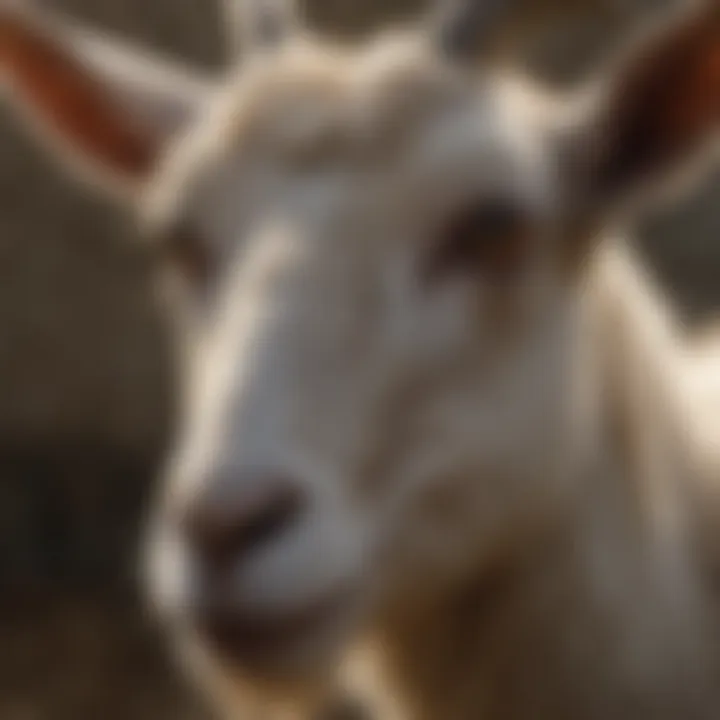
Benzimidazoles are a class of dewormers effective against a range of gastrointestinal parasites. They work by inhibiting the energy metabolism of worms, leading to their death. This class is a popular choice due to its effectiveness and broad spectrum. One key benefit of benzimidazoles is their low toxicity to goats, making them safe for most ages. However, one downside is the development of resistance, especially if used repetitively without rotation with other classes. Therefore, they should be employed judiciously to maintain their efficacy over time.
Macrocyclic Lactones
Macrocyclic lactones represent another major group of dewormers. These treatments offer highly effective control against various parasites, including those resistant to other classes. The unique feature of macrocyclic lactones is their long-lasting action, often providing weeks of protection. This can reduce the frequency of treatments needed. Nevertheless, they have some limitations, particularly regarding their efficacy against certain gastrointestinal nematodes. Careful management of their use is necessary to combat the rising issue of anthelmintic resistance.
Imidazothiazoles
Imidazothiazoles are particularly effective against certain roundworms in goats. Their mechanism of action includes paralysis of the parasites, leading to their expulsion. This class is known for its rapid action, making it an advantageous choice in cases where quick intervention is necessary. However, certain imidazothiazoles may have a higher toxicity risk, especially in young or stressed animals. Due to their potent nature, moderation in use is advised to ensure the long-term health of the goats.
Natural Deworming Alternatives
Natural deworming alternatives have gained attention as a viable method in goat management. Many goat owners prefer these options due to their perceived safety and lower environmental impact. Although they might not always offer immediate results like chemical treatments, many natural remedies can aid in maintaining long-term health. Understanding different natural methods is essential for effective parasite management.
Herbal Remedies
Herbal remedies have been historically used for their potential benefits in parasite control. Such remedies include garlic, wormwood, and diatomaceous earth. These plants often have the ability to create an unfavorable environment for parasites. The unique feature of herbal remedies is their holistic nature, typically posing fewer side effects compared to chemicals. However, their effectiveness can vary widely, and some may require more frequent administration.
Essential Oils
Essential oils can also serve as a natural deworming strategy. Oils such as peppermint and oregano exhibit anti-parasitic properties. They can disrupt the digestive processes of parasites, leading to their elimination. The appeal of essential oils lies in their potency and the minimal risk they pose to goat health if used properly. Nevertheless, their application can be more labor-intensive, and they may need to be incorporated into a broader management plan to ensure effectiveness.
Organic Feed Additives
Organic feed additives can enhance the goat’s overall health while also helping in parasite management. These additives often include probiotics and specific herbs aimed at boosting the goat's immune response. The primary advantage is that they can improve gut health and nutrient absorption, creating conditions less favorable for parasitic infestations. However, a potential drawback is that they may not provide rapid results compared to conventional chemicals.
Integrating both chemical and natural methods can maximize efficacy and minimize resistance while ensuring sustainable goat husbandry.
Selecting appropriate methods of deworming is crucial in protecting goat herds from parasites. Each approach has its benefits and limitations. A strategic combination of chemical and natural treatments can lead to healthier goats and a more sustainable farming practice.
Timing Your Deworming Schedule
Timing your deworming schedule is essential for effective management of goat health. Worm infestations can vary significantly with seasons and the ages of the animals, making the timing of treatments crucial. The right timing can maximize treatment efficacy and minimize resistance. By understanding the appropriate periods for deworming, farmers can increase the productivity and welfare of their herds.
Seasonal Considerations
Spring and Summer
Spring and summer are often periods of increased parasite prevalence. With more favorable weather conditions, parasites thrive and reproduce, leading to higher infection rates. During these seasons, goats spend more time grazing, further increasing exposure to parasites in the pasture. Regular deworming during this time helps manage infestations effectively.
The key characteristic of spring and summer is the abundance of lush pastures, which, while beneficial for the goats' nutrition, can also harbor numerous worms. Farmers often find this period a popular choice for initiating deworming programs. However, the unique feature of this timing is the need for careful monitoring. The advantages include improving overall herd health, while the disadvantage could be overlooking early signs of infestations, leading to severe outbreaks.
Fall Preparations
Fall is a critical time for preparing goats for winter. As temperatures drop, parasites may become less active, but that does not mean they are absent. Fall preparations should include a comprehensive assessment of the goat's health and a deworming dose to eliminate any remaining parasites.
The key characteristic of fall is the transition period. It is a beneficial time to assess herd health and implement necessary treatments before winter sets in. A unique feature of fall is the need to strategize; it is not merely about deworming protocols but understanding environmental conditions affecting parasite life cycles. The advantages include reducing the parasite load before a stressful winter environment, while disadvantages might involve timing it incorrectly or failing to account for existing infestations.
Winter Management
Winter management presents unique challenges for goat herds. With goats often confined to smaller areas, the risk of parasites can either increase or decrease based on management practices. Effective winter management involves ongoing monitoring and treatment as needed.
The key characteristic of winter management is the confinement of the herd, which can increase stress levels and susceptibility to infestations. Treating during winter is a beneficial choice as it aids in maintaining herd health during a critical period. The unique feature of this timing is the emphasis on indoor conditions, which can change the dynamics of parasite exposure. The advantages include minimizing the risk of severe infestation when the goats are more vulnerable, while disadvantages could be a lack of visible signs of parasites due to insufficient outdoor grazing.
Age-Specific Worming
Kids vs. Adults
Kids and adults respond differently to deworming protocols. Kids, being younger and often more susceptible to parasites, require tailored approaches to ensure their health and growth. Adults might have established immunity but can still be at risk from significant infestations.
The primary characteristic of kids is their vulnerable immune systems, which means they require more frequent monitoring and possibly more aggressive treatment measures. This focus is crucial for preventing delays in growth and development as kids are particularly sensitive to parasitic infections. On the other hand, while adults usually require less frequent worming, they must still be monitored for any emerging threats, especially in stressful conditions.
Pregnant and Lactating Does
Pregnant and lactating does require careful consideration when planning deworming schedules. This group is crucial because their health directly influences the growth and health of their offspring. Hormonal changes and nutritional demands can alter the effectiveness of dewormers as well.
The key characteristic here is the need for safe treatment options that will not harm the fetus or young kids. This consideration is vital as it ensures the health of both the doe and her future offspring. The unique feature of this group is the balancing act between effective treatment and safety. The advantages of focused management include reducing the risk of transferring parasites to kids, while disadvantages might include limited options for effective and safe anthelmintic treatments.
Assessing Anthelmintic Resistance
Assessing anthelmintic resistance is a crucial aspect of managing goat health regarding parasitic control. This evaluation helps farmers identify how well dewormers are working against parasites in their herds. Over time, parasites may develop resistance due to various practices, leading to reduced efficacy of the medications used. Therefore, recognizing resistance patterns enables targeted strategies that can improve treatment outcomes and overall herd health.
Identifying Resistance Problems
Factors Contributing to Resistance
Several factors contribute to the development of anthelmintic resistance in goat parasites. One significant factor is the overuse or misuse of dewormers. When farmers consistently administer the same type of dewormer, it puts selective pressure on the parasite population, allowing the more resilient individuals to survive and reproduce. This reinforces the need for careful management of drug usage in goats. Additionally, environmental factors such as poor pasture hygiene can exacerbate the problem. Infestations persist, creating a continuous cycle of resistance. Understanding these contributing factors is vital for proactive herd management.
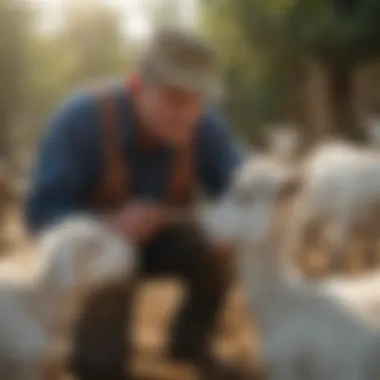
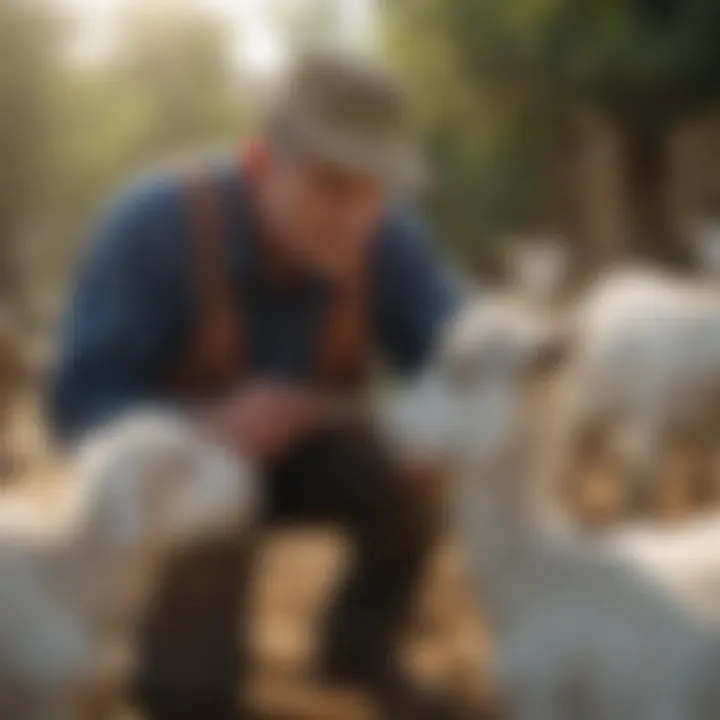
Signs of Resistance in Deworming Efficacy
Recognizing signs of resistance in deworming efficacy is important for farmers to adapt their strategies. A key characteristic is the persistent presence of parasites in feces despite deworming treatment. If goats continue to show symptoms of parasite infestation after treatment, it could indicate that the current dewormer is becoming ineffective. Another sign is a high fecal egg count post-treatment, which suggests that the parasites have developed resistance. Early identification of these signs allows farmers to change their approach quickly, which is beneficial for maintaining goat health and productivity.
Managing Resistance
Rotation of Dewormers
The rotation of dewormers is a strategy that can minimize the chances of resistance developing in goat parasites. This practice involves using different classes of deworming agents over time, which can help disrupt the life cycles of the parasites. By not relying on a single treatment method, farmers can effectively lower the pressure on parasites to mutate and adapt. It's a well-regarded method due to its simple implementation and potential to prolong the effectiveness of existing dewormers. However, it requires careful planning and record-keeping to understand which dewormers have been used and their outcomes.
Fecal Egg Counts
Fecal egg counts are an essential tool in managing resistance. This method involves testing goat feces to determine the number of parasite eggs present. High egg counts indicate the need for treatment, while low counts suggest that deworming may not be necessary. This approach is economical and helps farmers avoid unnecessary treatments that could contribute to resistance. It also provides a clear picture of the parasite burden within the herd, allowing for informed decision-making about deworming schedules and methods. Regular monitoring helps in adapting to changes in the parasite population and maintaining healthy goats.
"Effective management of anthelmintic resistance requires both knowledge and strategic planning. Understanding the dynamics of parasites and treatments can lead to healthier herds and better production outcomes."
Overall, assessing and managing anthelmintic resistance is vital for maintaining the health and productivity of goat herds. This proactive approach ensures that parasite control remains effective and sustainable.
Integrating Worming into Herd Management
Integrating worming into herd management is crucial for enhancing the health, productivity, and overall sustainability of goat farming. This approach goes beyond merely treating infestations. It involves creating a comprehensive strategy that takes into account various factors influencing the goats’ exposure to parasites. A well-structured worming protocol not only helps in reducing parasite loads but also supports healthier immune systems in goats.
Effective integration of worming into herd management encourages a balance between treatment options and preventative measures. One key consideration is to synchronize worming practices with management decisions such as grazing systems, habitual movements, and breeding cycles. This thoughtful planning minimizes the chances of re-infestation and maximizes the effectiveness of deworming efforts. Moreover, routinely monitoring goat health and adapting worming schedules based on observed needs can significantly optimize animal welfare.
Pasture Management Techniques
Rotational Grazing
Rotational grazing involves dividing pastures into smaller sections. Goats are moved systematically between these sections. This method reduces parasite transmission by preventing goats from re-grazing contaminated pasture. The key characteristic of rotational grazing is its adaptability. It allows for the recovery of pasture land and can lead to better nutrition for goats.
The unique feature of rotational grazing is its impact on soil health and grass growth. When pasture is given time to rest, it can regenerate. This contributes to a healthier ecosystem. However, managing multiple pasture systems requires planning and monitoring. It may not be feasible for all farms, especially those with limited land availability.
Mixed Species Grazing
Mixed species grazing includes having goats graze alongside other livestock such as sheep or cattle. This approach can decrease parasite loads, as different species host different parasites. A key characteristic of mixed species grazing is the diverse nutritional benefits it provides. Different species graze on various types of forage, promoting healthier pastures.
The unique feature of mixed species grazing is enhanced biodiversity in pastures. This practice can lead to reduced chemical inputs and improved land use. Yet, there can be challenges like potential competition for feed resources and the need for careful management to prevent conflicts among species.
Monitoring and Record-Keeping
Health Records of Each Goat
Keeping thorough health records for each goat is essential for effective herd management. This practice aids in tracking individual health issues, including signs of parasitic infestations. A key characteristic of maintaining health records is personalized attention to each goat. This helps farmers to notice trends and react promptly to health concerns.
The unique feature of detailed health records is their role in informed decision-making. They allow for adjustments in feeding, breeding, and treatment strategies based on health patterns. Yet keeping accurate records can be time-consuming and requires diligence from farm staff.
Worming History Tracking
Worming history tracking involves documenting all deworming treatments administered to each goat. This practice provides insights into the effectiveness of different treatments and helps in identifying resistance patterns. A key characteristic of this tracking is its ability to inform future deworming choices.
The unique feature of tracking worming history is its contribution towards a proactive worming strategy. Having a clear view of past treatments allows farmers to rotate dewormers effectively and plan for seasonal variations. However, it can take time to establish a consistent tracking system and requires discipline in record-keeping.
Future Trends in Goat Worming Practices
Future trends in goat worming practices are essential for evolving the methods of parasite control in goat farming. As knowledge around goat health and parasite management develops, it is important to focus on innovations that can lead to better outcomes for goat welfare and farm productivity. Here, we will explore advancements in deworming research and the role of technology in herd management.
Advancements in Deworming Research
New Active Ingredients
The developments in new active ingredients for dewormers signify a major step forward in parasite management. These ingredients are structured to target specific types of parasites more efficiently than previous formulations. One key characteristic of new active ingredients is their ability to reduce resistance among parasites. For this reason, they become a beneficial choice for effective deworming practices.
These new formulations often integrate compounds that disrupt the metabolic pathways of parasites in unique ways. This not only increases efficacy but can also potentially reduce the frequency of treatment needed, which is advantageous for farmer’s operational costs. However, the development and deployment of these substances require thorough research to ensure they are safe and efficient.
Genomic Studies of Parasites
Genomic studies of parasites represent a growing field in understanding how these organisms interact with their hosts. This research aims to delineate the genetic basis of resistance and susceptibility in parasites. One significant advantage of genomic research is its potential to reveal targets for new deworming agents. Moreover, this can lead to tailored treatment strategies based on the specific genetic makeup of both the goats and the parasites present.
The unique feature of this scientific approach is the deeper knowledge it provides into the life cycles of parasites. Implementing these strategies can mitigate the risk of uncontrolled parasite proliferation. However, genomic studies can be resource-intensive, requiring precise methodologies and technologies that may not be accessible to all goat farmers.
The Role of Technology in Herd Management
Data Analytics
Data analytics is becoming increasingly integral to modern herd management. It provides insights by aggregating and analyzing information about goat health and parasite loads. One notable characteristic of using data analytics in this context is the ability to make informed decisions based on real-time data.
The benefits of employing data analytics include improved monitoring of herd health trends and spotting potential issues before they escalate. By employing this technology, farmers can enhance their operational efficiencies and optimize deworming schedules according to observed patterns. However, implementing data analytics may require suitable infrastructure and knowledge, which can be barriers for some farmers.
Mobile Applications for Monitoring
Mobile applications for monitoring offer another substantial innovation in goat management. Such apps can track health records, treatment histories, and grazing patterns effortlessly. One key advantage of mobile applications is their accessibility, allowing farmers to receive important insights on the go.
These applications often feature user-friendly interfaces that simplify data entry and retrieval. The ability to quickly access health records and manage treatments is beneficial for maintaining herd health. However, reliance on technology may present challenges for farmers not as comfortable with digital platforms.
"Investing in the future of goat worming practices requires a blend of scientific innovation and technological integration to maintain effective control over parasites, ensuring the health of both livestock and the viability of farming operations."



